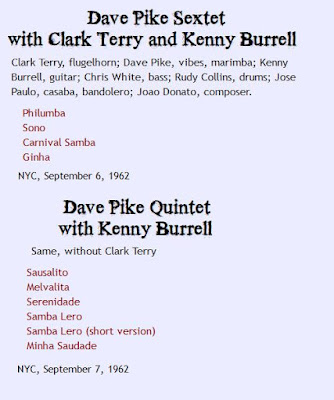LISTEN TO ONE: If I Loved You
A short session for Miss Jones--one song to fill out Hollar!, being readied for release, and three for a future project. She would be back in the studio in early 1963, and the three sessions together would make her last recording sessions for Prestige, to be issued as Love Shout, which was actually released before Hollar! Why these titles for these two albums is anyone's guess, as Jones was a singer, not a shouter. But then, a lot of the marketing decisions over the course of her long career may not have been the best ones, as her reputation has always seemed to lag behind her talent.
This is an interesting session in terms of song selection, leaning toward songs on the sweet end of the spectrum, not necessarily the first choices for most jazz singers--although other songs from not exactly hipster sources, like Sigmund Romberg and Rudolf Friml, have become jazz standards.
The session begins with Rodgers and Hammerstein's "If I Loved You," from Carousel, a much-loved standard for pop singers, bel canto and even operatic voices, not so many jazz singers. Doo wop singers of the 1950s breathed new life into a lot of standards and show tunes, but not this one--perhaps it was too resistant to a rhythm and blues spin. Dinah Washington recorded it twice, and Sarah Vaughan once. Dinah's first in 1950 with an orchestra led by drummer Teddy Stewart, and some melodramatic, almost coloratura, belting. the second a decade later with Quincy Jones. Both featured lush strings and an orchestral mood, as did Sarah's--I don't know the arranger or orchestra leader.
It goes without saying that both Dinah and Sarah can do no wrong with a song. Etta may not quite have the vocal chops of those two ladies, because no one has (except Ella, of course), but I do believe that Etta has the definitive jazz interpretation. She swings it, with a killer assist from Jerome Richardson on flute. Etta has always had the unique ability to channel other jazz singers without sacrificing her own individuality, and she does that here, starting out the way Dinah might have if she'd had Richardson, Kenny Burrell and Bucky Pizzarelli swinging her along, but then taking it to places that are pure Jones. For jazz, she owns this tune.
"Hi Lili, Hi Lo" was written for the Leslie Caron / Mel Ferrer movie Lili by composer Bronislau Kaper and Helen Deutsch, the film's screenwriter and not otherwise a lyricist. It was a 1952 hit for Dinah Shore before the movie came out, then everlastingly associated with the character of the sweet, innocent orphan who talked to puppets. It became a standard, mostly for girl singers with sweet, innocent voices, like the Lennon Sisters, the Chordettes, or Teresa Brewer--although Jimmy Durante also sang it (a weird masterpiece), as did the Everly Brothers (mistake), Manfred Mann (mistake), and Gene Vincent (oddly enough, not so bad). But jazz singing is mostly not about sweetness and innocence, although one of the great jazz vocals of all time is pure sweetness and innocence--Ella's "A-Tisket, a-Tasket," which works so well because there's no knowing wink behind it.
Jones respects the sweetness of "Hi Lili, Hi Lo." There's no knowing wink behind her rendition. But there's musical sophistication in the guitar parts especially, and if she doesn't swing it the way she does "If I Loved You," she gives it a nice bluesy touch.
Nat "King" Cole was never an innocent orphan who talked to puppets, for all his silky voice, and his
"Nature Boy" was a song about an innocent, not a song of innocence. It's a prodigiously recorded song -- nearly 600 versions, with lyrics translated into a bunch of languages including French, Italian, Portuguese, and three different Finnish translations, and yet it remains always Nat "King" Cole's. Etta Jones won't change your mind about that, but her knowing, smoky version, shorter than any of the other songs on this session, has its own very real words, not the least of them being Jerome Richardson's sax solo.
There's no question about the jazz credentials of "A Gal From Joe's" -- it was written by Duke Ellington, and his original 1938 recording features a memorable Johnny Hodges solo. And it's a good tune, but one that never caught on the way so many Ellington songs have -- in fact, Jones's 1962 recording was the first to feature a vocal. Nina Simone would record it a couple of years later, and her version is the best known. Contemporary singer Deborah J. Carter has recorded it, and that's about it. The lyric, credited to Ellington's manager Irving Mills, is odd -- is the gal leaving Joe's because she's dying? Because she's been arrested for murder? Or just because she's tired of Joe? Anyway, Jones does a fine version of a tune that deserves more attention than it's gotten, with wonderful solo and ensemble work from the musicians.
Also on this gig -- Sam Bruno, playing both organ and piano, although he's probably better known as a bassist; Ernest Hayes on bass (can't find any other credits for him, unless he's Ernie Hayes the piano player--he's certainly not Ernest Hayes the bass fisherman); and Bobby Donaldson, who's made several Prestige sessions, including a few backing up vocalists, and who brings a lot to this date.
Three of the four songs made it onto 45 RPM releases. "Nature Boy" and "Hi Lili, Hi Lo" were one entry. "A Gal from Joe's" was paired with "Some Day My Prince Will Come," from one of the later sessions. Esmond Edwards had brought Jones to Prestige, but Ozzie Cadena produced this and the later Love Shout sessions.

:format(jpeg):mode_rgb():quality(90)/discogs-images/R-8715545-1467210479-1466.jpeg.jpg)


.jpg)
.jpg)


:format(jpeg):mode_rgb():quality(40)/discogs-images/R-14611341-1578155772-8073.jpeg.jpg)
















:format(webp):mode_rgb():quality(40)/discogs-images/R-3060866-1339586709-2356.jpeg.jpg)